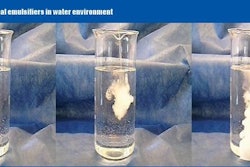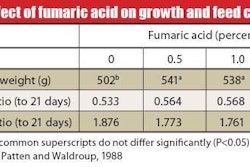
Driving through the Kentucky countryside, you can't help but be struck by the warmth of its people and the tidy beauty of its rural landscape. Make a stop at the Southern States Cooperative-Park City plant and those attributes of ‘can do' attitude and orderliness are even more evident. Nestled in the heart of the Bluegrass, about mid-way between Louisville and Nashville, the winner of the 23rd annual Feed Mill of the Year contest exhibits amazing attention to detail in all facets of its operation.
Feed Management visited with Plant Manager Gary Huddleston and Plant Superintendent Garrett Costello a couple of months ago to learn a little more about what made this particular facility rise to the top from among some of the best feed facilities in the country.
Recognizing excellence
The American Feed Industry Association (AFIA) and Feed Management co-sponsor the Feed Mill of the Year Award and together made the trip to tour the feed plant and visit with management of the facility selected as winner of the 2007 competition.
The annual Feed Mill of the Year contest seeks to recognize excellence in feed mill operation, including efficiency, safety and biosecurity competencies. The contest not only provides recognition within the industry, but has become a mechanism for participating feed mills to gain some valuable insight on how they can improve and how they match up against other top facilities in the country.
The 2007 Feed Mill of the Year program underwent a strategic redesign process based on changes recommended by the AFIA Production Compliance Committee. Among other revisions, the committee incorporated a new grading system that provided benchmarking feedback to every plant that entered the competition.
AFIA Vice President of Manufacturing and Training Keith Epperson says the changes were well-received by the industry and helped make the program the most meaningful ever. "Many previous participants have indicated that the greatest value they receive comes from using this program as a continuous improvement yardstick for their plant operations and employee teams. Every plant that participates is a winner," Epperson says.
Certainly Southern States Cooperative-Park City has proven itself a winner. The commitment Huddleston and his management team have for a job well done' shines through in all aspects of the facility and is shared by employees serving a variety of functions at the plant. It is no coincidence that before achieving this year's title, the plant was recognized as a finalist in a number of AFIA and Feed Management-sponsored truck fleet and feed mill competitions going back over 15 years.
Community relations
One of the secrets to Southern States Cooperative-Park City plant's success is that management recognizes the value of well-trained, loyal employees, and knows how to instill the kind of pride necessary to be a consistent winner. While industry surveys have shown that finding and retaining quality employees is one of the biggest human resource headaches for feed mills these days, it speaks volumes that people in the surrounding community recognize positions at the Park City mill as some of the area's most sought-after, quality employment opportunities. Being a good corporate citizen within the community of Park City is a priority Huddleston has for the plant and its workforce. "Several of our employees are on the Park City Volunteer Fire Department. One of the things that we do to give back to our community is to allow them to go on fire and emergency runs during working hours whenever possible. Some of our employees have saved a lot of lives through the years while on these emergency runs," he notes.
The Park City facility was built in 1977 by T.E. Ibberson and has been continuously owned by Southern States Cooperative since its construction. In 1998, it underwent a major control system upgrade. Also in 1998, the facility completed installation of its tub production line. In 2002, the Park City location undertook a renovation project to enable it to better manufacture simple commodity blends to fit its market area.
"We serve central and western Kentucky with bulk feed delivery service. We ship tubs and blocks to various locations east of the Mississippi River. Our product mix is 75 percent bulk and 25 percent packaged--pressed blocks and tubs," explains Huddleston. "Approximately 52 percent of our tonnage is pelleted."
He notes that the plant's breakdown by species for its most recent fiscal year was 35.5 percent dairy, 34.8 beef, 25.6 percent poultry, and 4.1 percent all other species.
Huddleston says that in its last fiscal year ending June 30, the plant produced 67,254 tons. This fiscal year, he anticipates manufacture of approximately 70,000 tons of feed. A total of 27 employees contribute to the plant's success, including seven drivers, three in maintenance, two clerical persons, 12 production employees, and three members of management.
In visiting with the Southern States Cooperative-Park City plant management team, Feed Management asked Huddleston to talk a little bit about the plant's operations and its commitment to quality feed manufacture targeted to fit the marketplace.
FM: How have you seen your market change in the last five years and how has your facility changed to meet those needs?
Huddleston: Our tub production tonnage has continued to increase at a steady rate since we put the line into production in 1998. More farmers seem to be feeding tubs each year and we are also increasing our market share a little more each year. The increased tonnage has helped us to continue to improve our efficiency with this line. We've also seen a lot of our dairy and beef customers move in the direction of simpler commodity blends. Some of this is due to price pressure in the market place and some is due to farmers just following trends. We're starting to see a slow reversal of this trend towards more value-added products. These trends cause us to constantly review our offerings in the feed market.
FM: Describe for our readers your employee safety record. What safeguards do you have in place and what training do employees receive in regards to safety on the job?
Huddleston: We have logged 302,028 employee hours without a lost-time accident through February 2008. Our last lost-time accident was in 2003. We've had only one lost-time accident in the last six years. We have an employee cookout at each 100,000-hour milestone without a lost-time accident. We also have ice cream or other refreshments during safety meetings at 50,000-hour milestones. We have a very active safety committee that meets 12 times per year. Participation on the committee is on a rotating basis so that all employees will eventually serve. We also have monthly plant-wide safety meetings for training. Employees are trained annually in all required OSHA topics as well as other safety topics pertaining to our business. We also have a monetary safety bonus program for employees who accumulate years without an accident.
FM: Tell us a little bit about how your facility approaches regulatory and feed safety issues. What practices do you feel probably set your facility apart from others in terms of this area? How do you assure quality and feed safety?
Huddleston: We've had a HACCP program in place at our facility since 2005. We take our responsibility for safe feed/safe food very seriously. Southern States also has a rigorous quality control program for its feed plants which includes annual corporate audits.
Our plant has consistently set the pace within our corporate auditing program. Last year we scored 99.6 out of 100, which was the highest score ever recorded in the history of our auditing program.
FM: How does your facility work to improve efficiency? What practices or equipment do you employ to assure manufacturing efficiency?
Huddleston: We try to create a culture of excellence at Park City to where our employees embrace opportunities for improvement. Our main efficiency benchmark is man-hours per ton. We've been able to make steady improvement in that area through our attention to continuous improvement, employment of automation, and increasing our tonnage base without increasing employee numbers. In our fiscal year ending in June 1999, man-hours per ton were .72. In our fiscal year ending in June 2007, it was .44. We're on target to make an improvement upon that figure for our fiscal year ending in June 2008. Our manufacturing cost per ton was $6.18 lower in 2007 than in 1999.
FM: Your facility has gone through several advances since it was built 30 years ago. Tell us which technology upgrade you believe has had the greatest impact on the successful performance of the facility.
Huddleston: When we entered into a joint venture with Westway Trading Inc. in 1998 for the installation of our tub production line, the decision was made to totally automate the process. To our knowledge, that had never been done with a tub production line. Since we were also in the middle of a control system upgrade, it allowed us to integrate the two projects with the result being one of the most, if not the most, efficient tub production lines in the world. This has allowed us to produce feed tubs at very high production rates, which provides a much fresher product to our customers during the feeding season.
FM: In touring your facility, I can't help but be struck by the orderliness of the plant and the immaculate care of the surrounding grounds. How do you address issues of quality and a clean environment at your facility?
Huddleston: We have on file a Storm Water Pollution Prevention Plan (SWPPP), a Spill Prevention Countermeasure Plan (SPCC), and a Kentucky Groundwater Protection Plan (GPP). We also pay a lot of attention to the housekeeping in and around our facility. We take our environmental responsibilities very seriously.
FM: In talking with your employees, there seems to be a thorough knowledge of the plant's goals and a great deal of pride in the role each individual has to achieving those goals. How does your facility work to engage employees and what benefits or conditions do you feel set you apart from other employers?
Huddleston: We consider our employees our most important asset at Park City and allocate a lot of time to their development and management. To enhance employee engagement, operational meetings are held monthly where plant performance is discussed. Additionally, an in-depth employee performance appraisal process is held annually which provides another avenue for employee engagement with management.
Our goal is to create an environment where employees can enjoy working. Several of our employees have worked at our plant since it began operation in 1977. Our employees take a lot of pride and ownership in their plant and the accomplishments over the years. They truly want to be the best. While everyone works hard, our employees also have a lot of fun with each other while they work. We're not only co-workers at Park City, but life-long friends.
.jpg?auto=format%2Ccompress&crop=faces&fit=crop&h=48&q=70&w=48)


.jpg?auto=format%2Ccompress&fit=crop&h=167&q=70&w=250)














